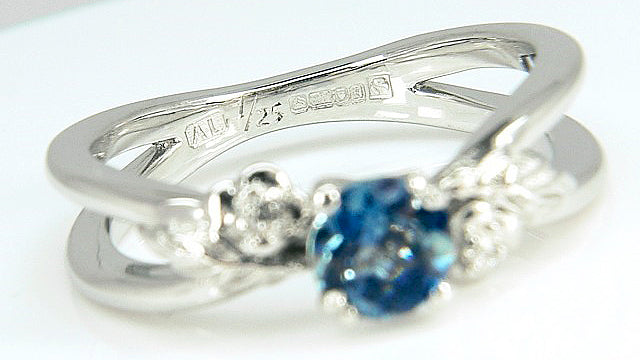Your Cart is Empty
It’s rare that a piece of jewellery is cast using 100% precious metal. Most jewellers combine precious metals with other metals in order to increase durability, make the metal easier to work with or make the finished jewel more wearable.
For example, many people are surprised to learn that platinum in its pure state is soft and unsuitable for creating jewellery. That’s why the most common type of platinum jewel is 95% pure platinum and 5% other metals that add critical technical properties - thus hallmarked '950'. Rhodium, for example, raises melting point and increases hardness, and often makes the platinum alloy appear brighter and whiter.
In many countries, it’s a legal requirement to brand jewellery with a mark that verifies the percentage of precious metal present. This is called hallmarking, and whilst it’s standard practise here in the UK, it’s not actually mandatory everywhere in the world. So what are the key differences between British hallmarks and those elsewhere in Europe?

The UK holds some of the strictest hallmarking laws in the world. Every piece of jewellery made from precious metal and sold in the UK must be sent to one of four Assay Offices, where government employees test each piece for its precious metal percentage and stamp them with the relevant hallmarks.
Historically, hallmarks in the UK were made by punching the mark into the metal with force. Today, it’s more common that lasers are used to etch the mark into the piece. The mark made depends on which of the four Assay Offices the piece was sent to, but the presence of the mark itself verifies that the piece was proven to contain the volume of precious metal that the jeweller advertised.
The possible Assay Office marks are an anchor for Birmingham, a castle for Edinburgh, a rose for Sheffield, and a leopard’s head for London. The leopard’s head is proudly displayed on most Lebrusan Studio jewels as an indication of their Hatton Garden provenance.

In addition to this legally required hallmark, jewellery must bear a purity mark (which consists of a two-digit numbers and the letter k, or a three-digit number) and a maker’s mark (which could be nearly anything, but is often initials or a logo). Our maker’s mark is ‘AL’ for ‘Arabel Lebrusan’. Additionally, if a piece of jewellery was created in Britain before 1999, it will bear a date stamp, a legal requirement of all British jewellery until that year.
If a piece of jewellery is created from a special third party-certified metal like Fairtrade Gold or Fairmined Gold, it will also bear a unique stamp that proudly verifies its provenance.
Like that of the UK, French hallmarking, known as "poinçonnage," is a highly regulated system wherein any gold, silver or platinum jewellery must be branded with a maker's mark, a purity mark and a regional assay office mark. Whilst Paris' assay office uses a variety of marks, including the Eiffel Tower, a profile of the Greek Goddess Minerva's head, and the letters 'A' or 'V' - Lyon employs the initials 'L' and 'Y' combined with stars and geometric shapes, and Strasbourg uses the letters 'S' and 'T' alongside floral designs.
Any jewellery created in a precious metal and sold in France must also bear a diamond-shaped mark with four equal sides, called a lozenge.
Hallmarking laws vary across the remainder of the European continent. Some countries, including Hungary, Sweden, Finland, and Russia, legally require the hallmarking of any silver, platinum or gold piece of jewellery. Elsewhere, like Italy, purity hallmarks are not required but maker's marks must be registered and those in themselves are independently recognised as an independently monitored hallmark.
The difference between a hallmark and a maker’s mark - even in a nation where maker’s marks are regulated - is that a hallmark indicates that the piece was physically sent to a third-party office and tested for purity. However, all European countries require maker’s marks to be registered. This honour system requires each jeweller, by law, to test their own pieces and advertise them honestly.
